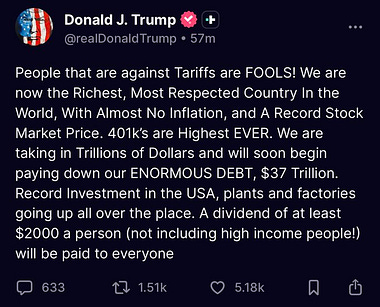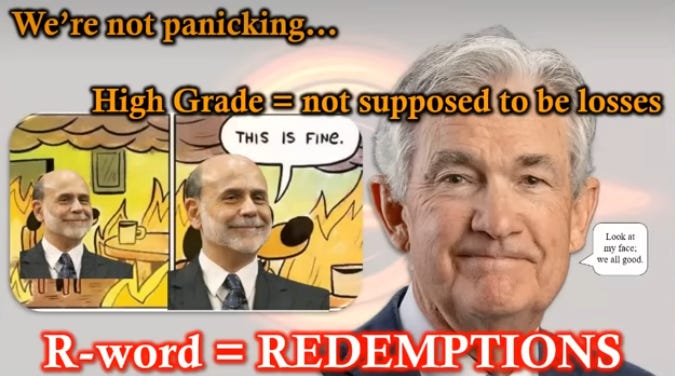Ukraine; Thinking About The Military; Stimulus Checks Are Back
November 9 | Posted by mrossol | Big Govt, Economics, Tariffs, Ukraine, US Debt, WauckI more or less agree with the second half relative to the economy, debt, currency, etc. I think it is just a question of how quickly it will all unravel. (Ukraine, I have thought for years that this is a lost cause for Ukraine and the West; what a shame all the lives lost and for what?) mrossol
Source: Ukraine; Thinking About The Military; Stimulus Checks Are Back
Today I came across a fairly brief video update on the war in Ukraine that goes beyond the typical SitRep format. For some time now the focus of most reporting has been on the Russian push to take the remaining fortified cities in the Donetsk oblast—Pokrovsk, Siversk, etc. This is all happening in what could be called the central sector of the eastern front. However, south of that area the Russians are making important and rapid advances in the Zaporozhye and Dniepropetrovsk oblasts. These advances are taking the Russian forces into open agricultural land, beyond the industrial and mining centers of the Donbass. That means that the built up Russian forces in these regions will be headed toward the important Dnieper River cities of Zaporozhye and Dniepropetrovsk—important in their own right, but also important because much of the remaining Ukrainian forces in Donbass could be cut off. There are basically no defensive lines in the way of the Russian forces. According to the narrator, the Russians are meeting little resistance from Ukrainian infantry. Instead, the Russian advance has developed into a battle of Russian infantry against Ukrainian drones.

Douglas Macgregor: Ukraine’s Twilight – the Endgame No One Admits
00:00 Defining Maneuver Warfare
05:23 Russian Commanders and Attitudes toward War
07:44 Underestimating the Enemy – Historical Parallels
12:32 Early Observations of the Ukraine War
21:48 Adaptation and Learning in Russian Forces
24:25 NATO and Organizational Weakness
28:48 Russian General Staff and Leadership Selection
32:28 Cultural and Tactical Blindness in Western Training
38:14 Current U.S. Deployments and Logistical Limits
40:05 Drones and the Changing Face of Warfare
42:02 Ukrainian Collapse and End of the War
The conclusion, as expected, is that Ukraine has lost and that the Anglo-Zionists should put an end to the incredibly inhumane decimation of their Ukrainian proxies. That’s a waste of breath, of course. Anglo-Zionists care nothing for humanity.
I’m going to transition to the economic front of the Anglo-Zionist war on the world via an article that traces the collapse of empires in history from a monetary standpoint. It’s too long to paste in, but I’ll try to give a flavor for the whole. Here’s the intro:
The Pattern That Ends Empires: How Money Dies Before Nations Fall
Empires don’t collapse from external enemies. Not through conquest. Not through revolution. They crumble from within, as trust in their money quietly decays — the slow death of their currency. Is the American Empire next?
To say this is the only cause would be an oversimplification. Empires rarely fall for one reason alone. Political corruption, social decay, foreign wars, and natural disasters all play their part. Yet beneath each of those crises lies a constant: fiscal overreach and monetary debasement — the erosion of the financial trust that holds civilization together.
When an empire’s currency fails, it is more than an economic event. It is a crisis of faith — a loss of confidence in the state’s promise, in the very idea of value. Money, after all, is trust made tangible — a shared belief that a symbol represents real worth. Once that belief breaks, no army or bureaucracy can restore it.
As historian Niall Ferguson wrote in The Ascent of Money (2008):
“Money is trust inscribed. When that trust dies, money dies — and when money dies, empires die with it.”
Niall Ferguson
What often happens—as we were discussing the other day—is that a failing empire refuses to accept the lessons of history and attempts, against all reason, to maintain its hegemony through military means. That appears to be where we are, judging from the volume of threats issuing from the Imperial City on the Potomac. The financial basis to back up those threats, as well as the military wherewithal, is failing.
The author then covers historical examples, which I’ll skip—except to note them—in order to get to the present:
Rome: The First Great Example of Monetary Collapse
Spain: Wealth Without Production
Britain: The Empire Built on Credit
At its height, the British Empire ruled a quarter of the world’s land and population. Its strength rested not on treasure, but on credibility. The pound sterling — backed by gold — was the global reserve currency.
…
Monetary Instability in Russian Empires
Is China an Exception?
Short answer: No, but …
In Asia, history is not a distant archive but a living standard by which present and future are measured. A central lesson in the Middle Kingdom spans the centuries: when the political center weakens, chaos follows—civil war, collapse, millions of deaths. This historical awareness still shapes China’s policies today. Gold reserves are hoarded, dependence on the dollar gradually reduced, risks broadly diversified. Behind this is no short-term pragmatism, but a deep instinct: stability means survival. Confidence in one’s own currency, political cohesion, and strategic foresight—all stem from experience, not forgetfulness.
Whether this is enough to escape the cycle of history remains uncertain. But one thing is clear: the lessons of past empires have not faded in China. They have been internalized—and acted upon.
From Rome to America: The Economic Pattern of Decline
Rome, Spain, Britain — different centuries, technologies, and enemies, yet the sequence is remarkably consistent:
- Expansion beyond sustainable limits.
- Fiscal deficits to maintain that expansion.
- Currency debasement or overissuance to cover the deficits.
- Inflation, followed by social unrest.
- Loss of confidence, both domestic and international.
- Collapse or forced contraction.
That sounds disturbingly familiar.
…
Why Currency Collapse Matters Most
Empires can survive military disasters, natural catastrophes, even civil wars — so long as their money retains trust.
But when money fails, it corrodes everything built upon it: the tax system, the army, the economy, and the social contract itself.
Monetary collapse doesn’t just mark the end of empire — it reveals how far the decay has already spread.
…
… Today, the United States faces unprecedented debt, its currency is under immense pressure, and the warning signs of an impending loss of confidence are unmistakable.
When the foundation falters, all structures are at risk: the economy, the military, society – nothing is spared. The lifespan of the American empire could therefore be far shorter than that of its illustrious predecessors, and its decline may come faster than many imagine.
With that, let’s turn to the latest signs of desperation. Trump is proclaiming that he has officially MAGAed, and to celebrate this great event he, the Great Victor in the Tariff War, will issue stimulus checks, 50 year mortgages, and God knows what else. Oh, and he has a bridge he wants to sell the yokels who believe any of this.
The Kobeissi Letter @KobeissiLetter
23h
BREAKING: President Trump announces 50-year mortgages in the US.
BTW, I hear that interest payments on a 50 year will amount to twice that for a 30 year.
On a $400K Mortgage at 7% Interest:
1. 30Y Mortgage: $558,000 in lifetime interest
2. 50Y Mortgage: $1,116,000 in lifetime interest
With a 50Y mortgage, you pay DOUBLE the amount of interest compared to a 30Y mortgage.
We are in a crisis.
We now live in a society where more debt is the “solution” to everything:
Can’t afford basic necessities? Take on more debt.
Can’t pay your tuition? Take on more debt.
Can’t afford to buy a home? Take on more debt.
Can’t keep inflation under control? Take on more debt.
Can’t run the government efficiently? Take on more debt.
There’s a reason why consumer sentiment is now below 2008 levels.
Our society is drowning in debt.
And to keep the masses quiet, they’re offered handouts—bread and circuses. But who paid for those tariffs in the first place? Debt is not a free lunch. One almost wonders whether Trump is desperately trying to pressure the SCOTUS.
The Kobeissi Letter @KobeissiLetter
7h
BREAKING: President Trump announces that he will be paying a “tariff dividend” of at least $2,000 per person.
Stimulus checks are officially back.
Ultimately, stimulus payments almost always end up being massive “involuntary taxes.”
That is; you pay multiples worth of your stimulus payment in the form of inflation.
President Trump just announced the “tariff dividend,” a payment of AT LEAST $2,000 per American.
We expect 85%+ of US adults to receive this, resulting in $400+ BILLION handed out.
All as US debt nears $40 trillion.
What’s next? Let us explain.
What could go wrong? Or, maybe: What could possibly go right?
BREAKING: Crypto surges after President Trump announces $2,000 tariff “dividends” to be paid out to Americans.
Rate Cuts + Record Highs + AI + Stimulus Checks.
Buckle up.
So far this weekend:
1. Trump announces 50Y mortgages
2. Trump announces $2,000 stimulus checks
3. Trump says insurance money should go to the people
4. Trump says tariffs will begin paying down US debt
5. Trump says no more money to insurance companies
2026 is going to be a wild year.
Today, President Trump announced that “high income people” will NOT receive tariff dividends.
However, in our view, “high income people” are going to receive the biggest dividend of all.
Why so?
Because, as we saw in 2020 and 2021, stimulus checks are almost always the largest form of “involuntary taxation through inflation.”
Those who own assets like stocks, real estate, crypto, and gold will see massive nominal asset growth.
These individuals also happen to be the “high income people.”
Everyone else benefits from a one-time spending boost, only to fall behind as inflation roars on.
Look. A check for $2K is literally and figuratively—take your pick, if you have to—chump change for the Middle Class. Sean Foo gets into some of this today:
U.S. Markets Terrible Crash As Bubble Implodes While China Cuts Silver Exports To America
The part about silver—vital in electronics—is quite interesting, and it goes along with other cuts in minerals that are essential for military products. Like, explosives. However, here are two brief quotes that should make anyone think:
Since ChatGPT was launched, job openings are down by 30% while the stock market is up by 70%. I want us to digest this fact. The consumer class in the US or the middle class is starting to collapse. But yet markets, especially tech stocks, they are flying to the moon. This can’t go on forever because reality always catches up. The AI bubbles being held together by shoestrings and bubble gum. And here’s the real worry. The administration refuses to admit there is a growing problem. The agenda is to call Main Street to tell everyone that things are fine so that more money can prop up the AI bubble.
Foo goes on to discuss the awful job reports, then:
This is what happens when domestic consumption drops and production cost keeps going up. Now imagine what will happen if more money is channeled into AI spending while ignoring the underlying economy. The bifurcation will get more and more skewed until we reach a tipping point. The tipping point is when people just refuse to spend, and when that happens the entire system will unravel. And let’s not forget that US GDP 70% of it is driven by consumption. And US consumer sentiment is collapsing.
Stimulus checks are gonna change that dynamic? Really? How about the end of the government shutdown that’s being strongly rumored?
Edward Dowd @DowdEdward
1h
If true this will pump markets (as liquidity will improve) for bit longer. Remember the shut down is an exogenous event just like tariffs. However, endogenous issues aren’t going away and are appearing now and will gather steam as we roll into 2026.









Leave a Reply
You must be logged in to post a comment.